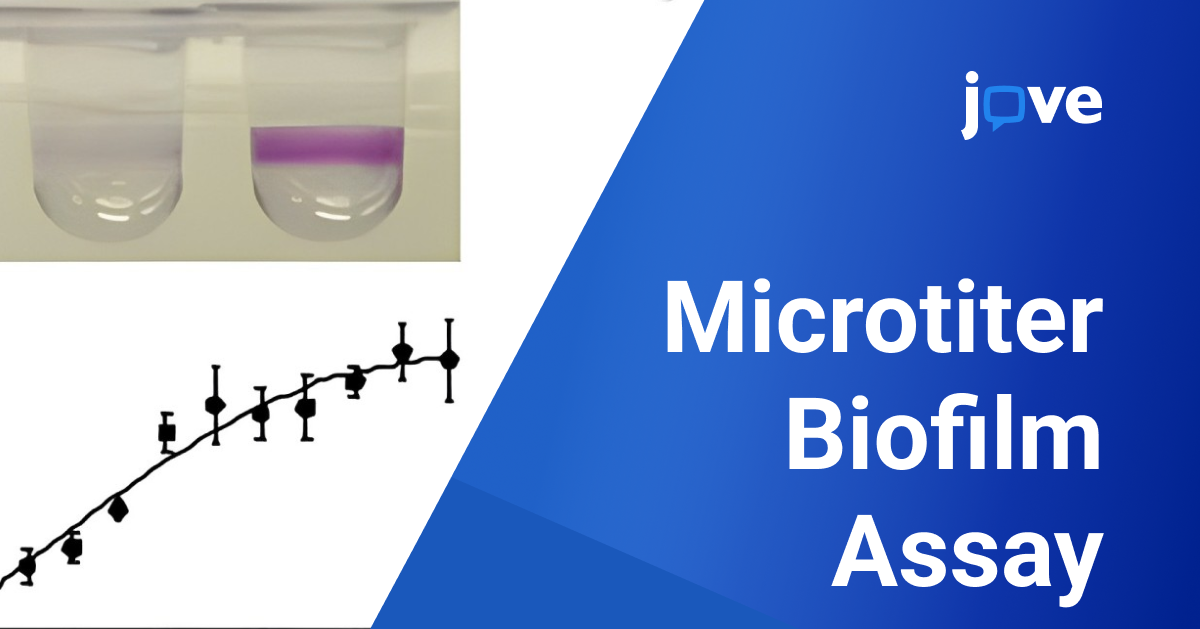In this blog post, we'll explore the Microtiter Dish Biofilm Formation Assay, a crucial quantitative method used to study biofilms in the lab. This assay is essential for understanding the biofilm-forming capabilities of various microorganisms under controlled conditions. Discover how this technique is detailed in protocols available on JoVE Journal.
What is the Microtiter Dish Biofilm Formation Assay?
The Microtiter Dish Biofilm Formation Assay is a widely used quantitative method for studying biofilms in a laboratory setting. This assay allows researchers to assess the biofilm-forming capabilities of various microorganisms under controlled conditions, as detailed in protocols available on JoVE Journal.
Assay Significance in Scientific Researches
Biofilms play a critical role in a variety of contexts, including medical device infections and environmental systems. The assay provides essential insights into the biofilm development processes, helping in the design of strategies to control or eradicate biofilms. Research findings using this assay are often published in JoVE Journal, highlighting its importance in scientific studies.
Common Microtiter Assay Applications
This assay is particularly useful in microbiology and medical research to evaluate the efficacy of antimicrobial treatments and understand the resistance mechanisms of biofilms, which are notoriously difficult to treat due to their protective structure. Studies using the Microtiter Dish Biofilm Assay can be found in JoVE Journal, providing a wealth of examples and methodologies.
How to Perform a Microtiter Dish Biofilm Formation Assay?
The Microtiter Dish Biofilm Formation Assay is a standardized method used to evaluate biofilm production by microorganisms on a surface.
This assay utilizes a 96-well plate to facilitate the growth, staining, and quantitative analysis of biofilms under various conditions.
1.Preparing the Assay
Preparation involves inoculating sterile microtiter plates with a microbial culture and allowing it to grow under optimal conditions. It's crucial to ensure uniform inoculation across wells to achieve reproducible results. JoVE Journal provides detailed video demonstrations that guide researchers through the preparation stages.
2.Analyzing Biofilm Formation
After incubation, the growth of biofilms can be quantified using various staining methods, such as crystal violet, which stains the biofilm but not the planktonic cells. The stain retained by the biofilm is then solubilized and measured spectrophotometrically to quantify the biofilm biomass. Detailed protocols and video tutorials for these methods are available on JoVE Journal.
Troubleshooting Common Issues
Common issues in the assay include variability in biofilm formation between wells and incomplete removal of planktonic cells. Standardizing the inoculum density and meticulous washing steps can help minimize these problems. JoVE Journal offers troubleshooting tips and alternative approaches that can help optimize the assay results.
By mastering the Microtiter Dish Biofilm Formation Assay with resources from JoVE Journal, researchers can gain valuable insights into the complex behavior of biofilms and their responses to various treatments, contributing to broader applications in both environmental and clinical settings.
How to Learn Microtiter Dish Biofilm Formation Assay with JoVE?
To learn the microtiter dish biofilm formation assay using JoVE.com, you can access a comprehensive range of resources that include detailed text explanations and step-by-step video demonstrations. Here’s how you can proceed:
-
Visit the Text and Video Guide: Start by visiting the page dedicated to the microtiter dish biofilm formation assay on JoVE at Microtiter Dish Biofilm Formation Assay. Here, you will find a written protocol along with explanations that outline the purpose and methodology of the assay.
-
Watch the Video Demonstration: JoVE provides a visual guide that can significantly enhance your understanding and ability to perform the assay correctly. You can watch the video in English at The Microtiter Dish Biofilm Formation Assay Video
-
Engage with the Protocol: Deepen your understanding by engaging with the Microtiter Dish Biofilm Formation Assay Protocol steps as demonstrated in the video. This visual approach helps clarify complex procedures and ensures you can replicate the assay with higher accuracy in your own lab setting.
-
Sign Up for a Free Trial: If you’re new to JoVE or need access to more detailed resources, consider signing up for a free trial to access the full content. You can start your free trial at this link. This will provide you with full access to JoVE's extensive library of scientific video articles and protocols.
